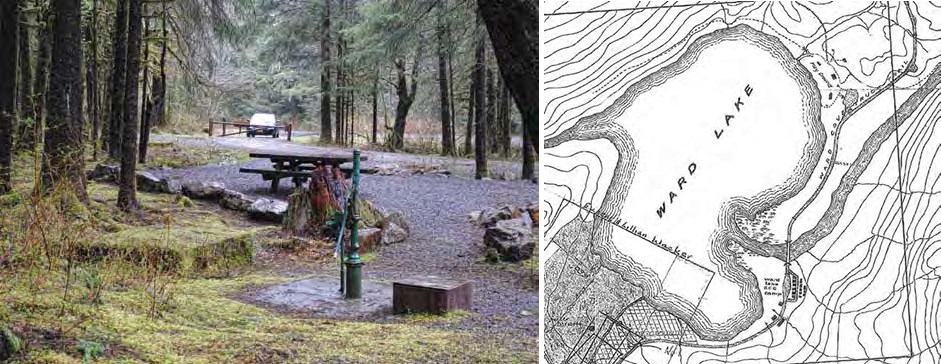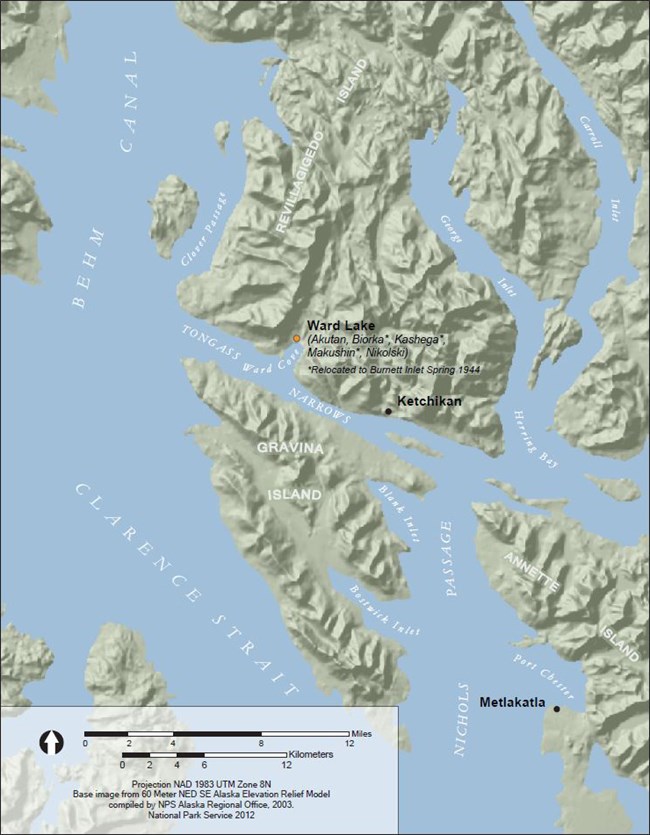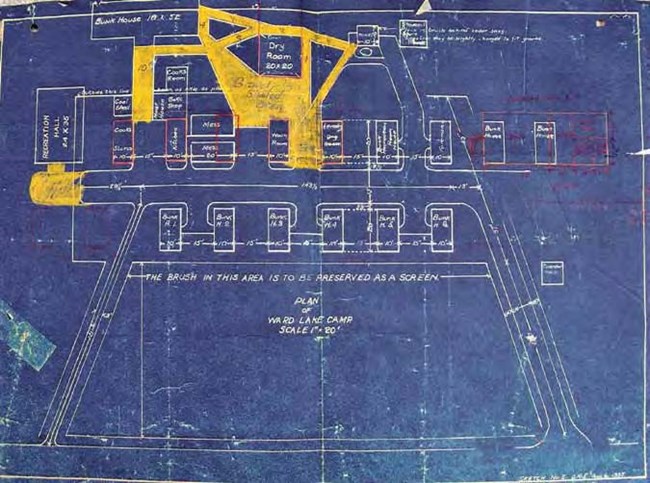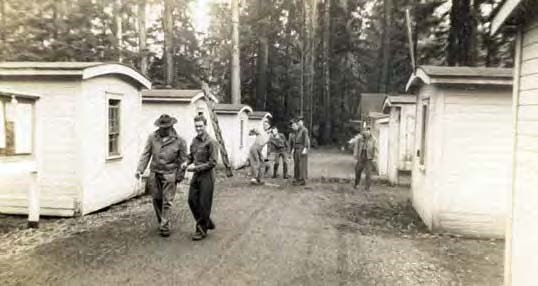Article
World War II Aleut Relocation Camps in Southeast Alaska - Chapter 7: Ward Lake CCC Camp

Right: Ketchikan Museum
The Ward Lake CCC camp – a federal work camp north of Ketchikan – became the wartime home for Aleuts from Akutan, Biorka, Kashega, Makushin, and Nikolski. Ketchikan is the southernmost town in southeast Alaska, in the heart of Alaska’s temperate rain forest. The average annual rainfall of 236 inches grows huge spruce, hemlock, and red and yellow cedar trees (U.S. Department of Commerce 1978:54), creating a deeply shaded understory (Figure 202). Ten miles northwest of Ketchikan along the shore of Revillagigedo Island is Ward Cove, fed by Ward Creek, which drains Ward Lake (Figure 203). Near the southeast shore of the lake, at the base of a mountain where the sun rarely shines, is the Ward Lake CCC camp (Figure 204).

Early Years
Ward Cove saw commercial activity as early as 1883-84 with the establishment of a saltery (Orth 1967:1028). Then, in 1912 – the same year the Burnett Inlet cannery was built, a cannery was built at Ward Cove (MacDonald 1949:33). In the late 1910s Eugene Wacker claimed a homestead between Ward Cove and Ward Lake, and his 160 acres became known as Wacker – later absorbed by the community of Ward Cove (Orth 1967:1028). In 1924 a coastal road known as the Tongass Highway was completed between Ketchikan and Ward Cove, and in that year Eugene Wacker began a commercial bus service between the two points (Ostlund 1980). This coincided with new federal policies supporting recreational use of public forests. Responding to the Ketchikan Women’s Club’s two new picnic areas built near the mouth of Ward Creek in 1925, and a Territorial Fisheries Department’s trail cut that same year, USFS during the following two years extended the trail around the lake and stationed two rowboats for public use (Ketchikan Museum 2008).

Left: Ketchikan Museum 99.2.1.4. Right: Ketchikan Museum
A decade later, public recreational facilities (Figure 205), workshops (Figure 206), and a residential camp were built at Ward Lake by the Civilian Conservation Corps (CCC) through the U.S. Forest Service (Rakestraw 1981:95-108). The CCC was created in 1933 under Franklin D. Roosevelt’s administration “to furnish employment, vocational training and educational opportunities for unemployed youth, to enable young men enrolled in the CCC to provide aid for their dependent families, and to advance a nationwide conservation program on forest, park, and farm lands” (Federal Security Agency 1940:1). By 1937 the CCC had over 1,000 men working in southeast Alaska to address “practically every human need in the territory, including airstrips, housing, fire and flood control, demolition, communications, sanitation, wells, cabins, trails, roads, bridges, shooting ranges, fences, floats and docks, dams, hatcheries, totem pole restoration, and archaeology” (Mobley 1992:4).

Ketchikan Museum U.S. Forest Service collection
Six small bunkhouses were completed at Ward Lake in 1935, soon followed by more buildings, creating a self-contained camp with the capacity for 65 men (Ketchikan Museum 2008). The bunkhouses were narrow cabins measuring 10’ x 20’, set on low piling foundations, with shallow rounded roofs. The standardized design was also used for other functions: a foreman’s cabin, cook’s storeroom, washroom, and laundry (Figure 207). The modular design allowed construction of a generator shed half the size of the cabins (Figure 208). One of the buildings was used as a kitchen, with two more appended at a right angle as mess halls.The identical buildings were aligned 20’ apart in two rows with their gable ends facing each other across a 20’ wide street. Other buildings on the plan include a large recreation hall, a large bunkhouse (18 ’x 52’), coal shed, bake shop, meat house, cook’s room, and toilet. These were frame buildings with gable roofs; archival photographs show some sheathed with board-and batten siding (Figure 209).

Left: Ketchikan Museum. Right: Ketchikan Museum U.S. Forest Service collection

Ketchikan Museum 99.2.15.18
Over the winter of 1940-41 and into the summer of 1941 the Ward Lake camp “served as one of the staging areas for the CCC and engineer troops, their one hundred trucks, five thousand tons of cargo, and one hundred prefabricated houses bound for Annette Island,” where a large airfield was being built as part of a chain of military aviation bases along the Pacific Coast (Sorensen 1995:239). For a short time during the winter of 1941-42 the CCC camp was unoccupied, then in late spring it was rehabilitated for housing and training the first class of “crash-boat” crews (Figure 210), the units deployed along Alaska’s coasts to rescue downed airmen (Bartholomew 1995:131). By Congressional decree the CCC ceased to exist in the autumn of 1942, and the U.S. Forest Service turned over all their equipment and supplies to the U.S. Army (Gruening 1942:5). The Army unit then vacated the Ward Lake CCC camp.
World War II and the Camp Experience
Bartholomew (1995:131) says his arriving military unit cleaned up the CCC camp buildings, which had been vacant less than a year, and lived in them until ordered to vacate so Aleut evacuees could move in. At that time the original 15-building CCC camp was intact, and in a photograph labeled June of 1942 all visible buildings are in their original locations (Figure 210). Villagers testifying in 1981 mentioned nine small cabins and three large buildings, approximating the original camp configuration. A timeline prepared by the Ketchikan Museum (2008) states that the CCC camp was closed in April of 1942, conflicting with the June date attributed to Figure 210, but either way the archival record suggests that the facility was intact and functional when it was turned over to the evacuees.
But when the 163 Aleut evacuees arrived at Ward Lake they found a compound designed for a group less than half their number. Kohlhoff (1995:103-104) says the “abandoned…camp consisted of a mess hall, a ‘toilet lavatory and urinal building,…two bunk houses and two cabins,’”in which “Aleuts had ‘to sleep…on the floor in their bedrolls and blankets’” or “had to stay in tents brought from Wrangell.” Construction began immediately on 16 new cabins using lumber shipped from Wrangell to Ketchikan on the same barge with the evacuees (Figure 211). Some of the new buildings were aligned to create a row parallel to the original cabins (Figure 212). These were probably located just west of the original cabins where, in 1935, planners had directed that “the brush in this area is to be preserved as a screen” (Figure 207). None of the cabins had running water, and one large privy served the entire community (Kohlhoff 1995:105, 109).
